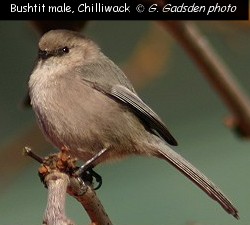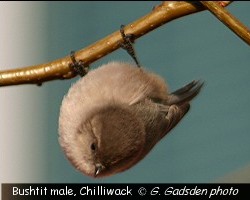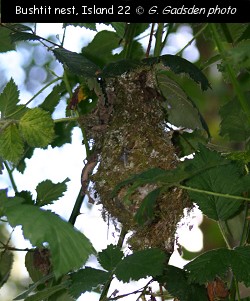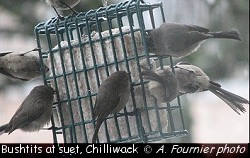The Bushtit
By Gord Gadsden
May 2007
The bushtit is a fascinating bird that makes up for its small size by having unique and interesting  habits. Bushtits can be recognized by their fluffy, soft-gray bodies, long tails and short dark beaks. Females have pale eyes while males and juvenile birds have dark eyes. habits. Bushtits can be recognized by their fluffy, soft-gray bodies, long tails and short dark beaks. Females have pale eyes while males and juvenile birds have dark eyes.
Bushtits can be found in most of our area but the Lower Mainland is about the most northerly extent of their range in North America. Fall, winter and early spring seem to be the best times to see them as they move around what appear to be their fairly large winter ranges. These energetic little birds are most often encountered in flocks moving rapidly through the lower story shrubs and trees calling constantly to each other. More often than not, you’ll hear a bushtit flock before you see them. They feed on small insects and spiders gleaned from the shrubs and trees and are quite acrobatic hanging upside down to inspect leaves and twigs for small insects. Bushtits are fairly common visitors in urban areas and will use a birdbath or eat some suet from people’s feeders as they travel. use a birdbath or eat some suet from people’s feeders as they travel.
Bushtits are non-migratory and when not breeding, travel together in large flocks of up to 70 birds consisting of several family groups. It has been noted that these flocks are often partially made up of the same individuals for several years. At night, the flock huddles together to help conserve warmth. Even during breeding when the winter flock disperses, usually within the parent flock's winter range, bushtits are friendly and non-territorial and will allow other bushtits who are not nesting to assist in nest building, egg incubation and feeding of the young.
The nest of a bushtit is an amazing piece of work.  Created of moss, lichens, grasses and spider webs, it hangs suspended from a branch like a sock with an entrance hole created in the side near the top. It can take up to 51 days to complete the nest but more commonly takes about two weeks. Five to seven eggs are laid once the nest is completed and are incubated by the male and female and sometimes the ‘helper’ bushtit. During the night, the pair roosts in the nest together. During this time, the pair is very susceptible to disturbance and will desert a nest if bothered. The young hatch in about two weeks and when they fledge, are welcomed into the family’s community flock. Created of moss, lichens, grasses and spider webs, it hangs suspended from a branch like a sock with an entrance hole created in the side near the top. It can take up to 51 days to complete the nest but more commonly takes about two weeks. Five to seven eggs are laid once the nest is completed and are incubated by the male and female and sometimes the ‘helper’ bushtit. During the night, the pair roosts in the nest together. During this time, the pair is very susceptible to disturbance and will desert a nest if bothered. The young hatch in about two weeks and when they fledge, are welcomed into the family’s community flock.
http://www.birds.cornell.edu/BOW/BUSHTI/
Ehrlich, Dobkin and Wheye, (1988)

|